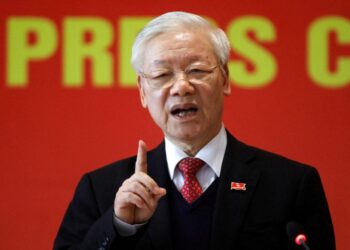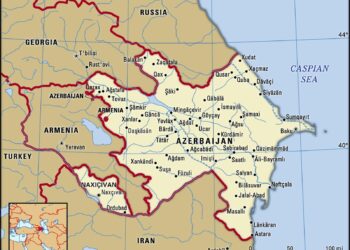As the arrival of spring heralds renewal across cultures, the Persian New Year, known as Nowruz, holds a special meaning in Azerbaijan, where vibrant traditions and deep-rooted customs converge in celebration of life and rebirth. This ancient festival, which marks the first day of the astronomical year and falls on the vernal equinox, is not only a time for family gatherings and feasting but also a profound expression of cultural identity and heritage.In Azerbaijan, Nowruz is infused with unique local flavors and practices, showcasing a rich tapestry of rituals that reflect the resilience and spirit of its people. Euronews delves into the colors, sounds, and festivities surrounding Nowruz in Azerbaijan, offering a glimpse into a celebration that not only welcomes the new year but also revitalizes the bonds of community and tradition.
Celebrating Nowruz: an Overview of Azerbaijan’s Persian New Year Festival
Nowruz, celebrated in Azerbaijan, is a vibrant festival symbolizing the arrival of spring and the rebirth of nature. This ancient holiday, which falls on march 20th or 21st, is deeply rooted in Zoroastrian traditions and has been heralded for over 3,000 years. The celebrations encompass various activities that reflect the cultural richness of Azerbaijan, including house cleaning, family gatherings, and traditional feasts. Festivals typically feature the setting up of a haft-seen table, adorned with seven symbolic items that represent health, wealth, and prosperity. Communities come alive with music, vibrant clothes, and elaborate fireworks as people engage in celebrating new beginnings.
Among the festival highlights is the traditional fire jumping ritual, where participants leap over bonfires, symbolizing the purification of the body and spirit. This practice not only signifies the clearing away of misfortune but also fosters a communal spirit as families and friends gather around the flames. Additionally,various cultural performances,including traditional dances and poetry recitals,showcase Azerbaijan’s rich heritage.The joy and excitement of Nowruz provide a perfect opportunity for Azeris to connect with their roots while embracing the rejuvenation that spring brings, making it a cherished occasion celebrated in both urban and rural settings.
cultural Significance of Nowruz in Azerbaijani Society
Nowruz, celebrated as the Persian New Year, holds a profound cultural significance in Azerbaijani society, symbolizing the arrival of spring and the rejuvenation of nature. This ancient festival marks the vernal equinox and fosters a spirit of unity among the diverse ethnic groups within Azerbaijan.The traditions associated with Nowruz encompass a myriad of customs that reflect hope, brotherhood, and the celebration of life itself. families come together to prepare symbolic dishes, clean their homes, and engage in festive activities that strengthen community bonds.
A central aspect of the celebration is the observance of various rituals that embody the spirit of renewal. Among these, the Haft-Seen table is especially noteworthy, adorned with seven items beginning with the Persian letter ‘S’, each symbolizing different facets of life. These include:
- Sabzeh – sprouts representing rebirth
- Samanu – sweet pudding symbolizing power
- Senjed – dried fruit representing love
- Seer – garlic symbolizing health
- Seeb – apples representing beauty
- somāq – sumac representing the sunrise
- Sirkeh – vinegar representing patience
The importance of communal activities cannot be overstated, as they foster a collective memory and cultural heritage that transcends generations. This celebration also reinforces Azerbaijani identity, showcasing traditional arts, music, and dance that form an integral part of Nowruz festivities. As people dress in vibrant attire and celebrate under the sun, they affirm their connection to nature and their rich historical roots.
Traditional practices and Rituals Associated with Nowruz
Nowruz, celebrated at the vernal equinox, is steeped in rich traditions and rituals that symbolize rebirth and renewal. In Azerbaijan, the festivities commence weeks before the actual day, creating a vibrant tapestry of cultural significance. Families engage in cleaning their homes, a practice known as “Khaneh Tekani,” signifying the removal of the old to make way for the new. this ritual is essential, as it reflects the hope for a fresh start. Additionally, the preparation of a special table known as “Haft-Seen” becomes a focal point where seven symbolic items beginning with the Persian letter “S” are displayed. These items typically include:
- Sabzeh (sprouted wheat or lentils)
- Samanu (sweet pudding)
- senjed (dried fruit of the oleaster tree)
- Seer (garlic)
- Seeb (apple)
- Somaq (sumac)
- Sirkeh (vinegar)
The first moments of Nowruz are often marked by joyous gatherings among families, where the sharing of traditional dishes plays an integral role. Throughout Azerbaijan, people celebrate with dishes such as plov (a fragrant rice dish), dishes made from herbs, and sweets like pakhlava. As the sun rises, it is customary for families to exchange gifts, particularly among children, fostering a sense of community and familial bonds. Moreover, the use of fire in various rituals symbolizes the burning away of past misfortunes, culminating in bonfires that are jumped over as an act of purification. This blend of joy, renewal, and unity truly encapsulates the spirit of Nowruz in Azerbaijan, honoring the essence of life itself.
Festive Foods: A Culinary Journey During Nowruz Celebrations
Throughout the Nowruz celebrations, the culinary landscape of Azerbaijan comes alive with vibrant flavors and traditional dishes that embody the spirit of renewal.each culinary creation takes on a significant meaning, reflecting the customs of the season. The festivities are incomplete without the presence of Sabzi Polo—a fragrant herbed rice dish often served with fish, symbolizing abundance and wealth. Accompanying this are Dolma, vine leaves stuffed with a mixture of rice, herbs, and sometimes meat, which signify the wrapping up of winter and welcoming the new life of spring. Additionally, Baklava—a sweet pastry made of layers of filo filled with nuts and honey—serves as a delicious reminder of the richness of life and the sweetness of relationships during this time of year.
Another essential aspect of the Nowruz table is the Haft-Seen, a symbolic table setting that includes seven items starting with the Persian letter ‘S’. Each item represents a different hope for the upcoming year, such as Senjed (dried fruit symbolizing love) and Seer (garlic representing medicine). Festive drinks like Doogh, a refreshing yogurt-based beverage, are also enjoyed, providing a cooling counterpoint to the rich dishes. As families gather around the table, sharing these special foods enhances communal bonds and serves to deepen the cultural ties that make Nowruz a cherished celebration across generations.
| Dish | Symbolism |
|---|---|
| Sabzi Polo | Abundance and wealth |
| Dolma | New beginnings |
| Baklava | Sweetness of life |
| Senjed | Love |
| Seer | Health |
Modern Adaptations: How Azerbaijan Celebrates Nowruz Today
The celebration of Nowruz in Azerbaijan has evolved substantially while retaining its deep-rooted traditions. This vibrant spring festival is marked by a series of festive activities that draw on both ancient practices and contemporary influences, making it a unique experience for all ages. Communities across the country come alive with traditional music and dance, with various performances showcasing local talent. Among the most significant elements of Azerbaijan’s Nowruz celebrations are:
- Sabzi Shirin: A dish symbolizing prosperity, made from sweet herbs and rice, enjoyed by families during festivities.
- Fire Jumping: A thrilling custom where participants leap over bonfires, a symbolic act believed to cleanse the spirit and bring good fortune.
- Halva and Sweets: traditional sweets, particularly halva, are prepared and shared, reinforcing familial bonds and joy.
- Khoncha Preparation: Decorative trays filled with colored eggs, fruits, and nuts are presented to guests, symbolizing hospitality and abundance.
In modern times, Nowruz in Azerbaijan has become not just a private family affair but also a public spectacle, with festivities taking place in parks and public squares. Cultural programs include art exhibitions,artisan markets,and performances that echo the spirit of renewal and hope that Nowruz embodies. The integration of digital platforms into celebrations has allowed younger generations to participate more actively, capturing moments and sharing experiences through social media. Below are some aspects of the festival that highlight its contemporary interpretation:
| Element | Description |
|---|---|
| Community Festivals | Local festivities featuring art, music, and food that bring people together. |
| Social Media Campaigns | Engaging content sharing stories and traditions to reach a global audience. |
| Environmental awareness | Promotions of sustainability, encouraging green practices during celebrations. |
Community Events and Public Gatherings for Nowruz
As the vibrant season of Nowruz approaches, various community events and public gatherings are set to light up the cultural landscape across Azerbaijan.This celebration of the Persian New Year not only marks the arrival of spring but also fosters a sense of unity and joy among communities. residents are invited to partake in a lineup of activities that embody the spirit of renewal and togetherness. Expect to see:
- Street Festivals: Colorful parades and dynamic performances showcasing traditional Azerbaijani music and dance.
- Food Fairs: Stalls offering mouthwatering dishes such as plov, dolma, and sweet pastries that characterize the Nowruz feast.
- Art Exhibitions: Displays of local artisans’ work, celebrating the rich heritage and craftsmanship of Azerbaijan.
Additionally,community centers are hosting educational workshops aimed at reconnecting the younger generation with their cultural roots. Participants can learn about the history and significance of Nowruz through engaging sessions that include:
| Workshop | Date | Location |
|---|---|---|
| Traditional Crafts | March 15 | Ateshgah Cultural Centre |
| Nowruz Cuisine | March 18 | Baku Culinary School |
| Folklore Storytelling | March 20 | Shirvan Park |
Promoting Environmental Awareness During Nowruz
As Nowruz approaches, communities across Azerbaijan embrace the season of renewal not just in celebration but also by fostering a commitment to environmental stewardship. Traditional rituals and festivities provide a perfect platform to educate attendees about the importance of preserving nature. By organizing workshops and activities that engage participants in eco-amiable practices, organizers can ensure that the spirit of renewal extends beyond personal beginnings to encompass the well-being of the planet. These initiatives include:
- tree Planting Drives: Encourage community members to plant native trees and flowers, reinforcing local biodiversity.
- Recycling Workshops: Demonstrate how to repurpose materials in creative and useful ways, reducing waste during celebrations.
- Clean-Up Events: Organize community clean-up activities in public spaces to promote cleanliness and respect for the environment.
The integration of environmental awareness into Nowruz traditions not only enriches the festive experience but also inspires a collective obligation toward sustainability. Schools and local organizations can play pivotal roles by incorporating educational elements into celebrations, perhaps displaying statistics and facts about local biodiversity and environmental issues. Such as:
| Fact | Significance |
|---|---|
| Over 80% of Azerbaijan’s plant species are endemic. | Highlighting the importance of habitat preservation. |
| Lost forests account for 25% of the country’s carbon emissions. | Encouraging tree planting as a means to combat climate change. |
Tips for Visitors: Experiencing Nowruz in Azerbaijan
Experiencing Nowruz in Azerbaijan is a mesmerizing journey into a world of tradition, color, and community spirit. To truly immerse yourself in this vibrant festival, participate in local celebrations throughout the Republic. Attend public events in major cities like Baku and Ganja, where you’ll find lively concerts, traditional dances, and theatrical performances showcasing the rich cultural heritage. Additionally, consider visiting rural areas to witness unique customs, such as the preparation of “samani”, a traditional wheat dish symbolizing rebirth and prosperity.
When planning your trip, take advantage of a few practical tips to enhance your Nowruz experience. Here are some essential suggestions:
- Engage with Locals: Don’t hesitate to strike up conversations with Azerbaijani families as they celebrate; many are eager to share their customs and dishes.
- sample Seasonal Foods: Indulge in local culinary delights like “shekerbura” (sweet pastry) and “pahlava” (baklava) that are specifically prepared for the festival.
- Join in the Traditions: Take part in activities such as jumping over the bonfires on the last day of the festival,symbolizing purification and renewal.
| Event | Date | Location |
|---|---|---|
| Gala Concert | March 19 | baku, State Philharmonic Hall |
| Traditional Market | March 17-21 | Ganja, City Centre |
| Fire Jumping | March 20 | Various locations |
Preserving Heritage: The Role of Nowruz in Azerbaijani Identity
Nowruz, celebrated on the vernal equinox, is more than just a festival marking the arrival of spring; it embodies the essence of Azerbaijani culture and identity. As communities come alive with vibrant colors and joyous gatherings, the traditions associated with Nowruz serve as a testament to the resilience and unity of the Azerbaijani people. Key elements of the celebration include:
- Nature’s Awakening: Symbolizing rebirth, families often engage in rituals that honor nature and its renewal.
- Family and Community: The holiday fosters stronger bonds as relatives and neighbors come together to share meals, stories, and traditions.
- Culinary Heritage: Special dishes prepared for Nowruz, such as sweets and pilaf, highlight the rich gastronomic culture unique to Azerbaijan.
Furthermore, the significance of Nowruz extends beyond mere festivities; it functions as a cultural touchstone that connects generations. The preparation of haft-Seen, a table set with symbolic items, encapsulates the values and aspirations of the Azerbaijani people. Each item represents a different hope for the upcoming year, such as:
| Item | Symbolic Meaning |
|---|---|
| Sabzeh (Sprouted wheat) | Rebirth and growth |
| Seer (Garlic) | Health and protection |
| Samanu (wheat pudding) | Affluence and wealth |
Through these time-honored practices, Nowruz reinforces a collective identity rooted in heritage, fostering a sense of belonging and cultural pride among Azerbaijanis across the globe. The festival not only commemorates the past but also shapes the future by instilling values of unity,love,and hope in the hearts of the community.
The Impact of Nowruz on Tourism and Local economies
Nowruz,celebrated with fervor across Azerbaijan,generates significant momentum in both tourism and local economies. As the Persian New Year festival symbolizes renewal and rebirth, it draws countless visitors eager to immerse themselves in its rich cultural heritage. This annual influx stimulates various sectors, particularly in hospitality and retail, as tourists flock to experience traditional festivities and local customs. The vibrant atmosphere encourages spending on accommodations, dining, and artisanal crafts, amplifying the economic impact on communities that embrace this ancient tradition.
The local economy experiences a multifaceted boost as Nowruz highlights regional artistry and craftsmanship.Markets teem with local goods such as:
- Handcrafted decorations
- Traditional sweets
- Colorful textiles
Additionally, cultural events such as music performances and dance showcases offer platforms for local artists, further fostering a sense of community and pride. The festival not only preserves age-old customs but also enhances the tourism infrastructure, paving the way for enduring economic growth. Local businesses are motivated to innovate their offerings, ensuring that visitors enjoy an authentic and memorable experience during their stay.
Comparative Analysis: Nowruz Celebrations Across the Region
The vibrant celebration of Nowruz, marking the Persian New Year, encompasses a rich tapestry of customs that vary significantly across different regions, each adding its unique flavor to this age-old festival. In Azerbaijan,the festivities are characterized by an unparalleled enthusiasm that transforms cities and villages alike into arenas of joyful renewal. The preparation for Nowruz often begins weeks in advance, featuring activities such as cleaning homes, planting sprouts (known as sabzeh), and organizing communal celebrations that highlight the values of family and community. Key elements of the Azerbaijani celebration include:
- Chardak: An elevated platform where families gather to celebrate.
- Fire-jumping: A symbolic act of purification and rebirth.
- Cuisine: Traditional dishes prepared specifically for the festival, such as plov, dolma, and shekarbura.
As we compare the Nowruz celebrations in Azerbaijan with those in neighboring countries, similarities in themes of rebirth and renewal emerge alongside distinct regional practices. As an example, in Iran, the Haft-Seen table—a traditional arrangement of seven symbolic items—takes center stage, while in Turkmenistan, the emphasis is on wealth and prosperity as families engage in various festivities. The following table succinctly highlights just a few of these differences:
| Country | key Feature | Culinary specialty |
|---|---|---|
| Azerbaijan | Chardak gatherings | Plov |
| Iran | Haft-Seen table | Sweet pastries (Baklava) |
| Turkmenistan | Wealth-themed celebrations | manti (dumplings) |
Future of Nowruz: Challenges and Opportunities in Azerbaijan
The celebration of Nowruz in Azerbaijan stands at a crossroads as it faces both significant challenges and remarkable opportunities. As globalization encroaches on local cultures, the essence of this ancient festival might seem at risk.Rapid urbanization, shifting demographics, and the influence of modern lifestyles can dilute traditional practices. Communities are grappling with the dilemma of preserving their heritage while embracing innovation. However, this evolving landscape also paves the way for a revival of interest in cultural identity among the younger generation.Schools and local organizations are increasingly engaged in educational initiatives to promote traditional Nowruz customs, ensuring that the festival remains relevant in contemporary society.
On the other hand, the potential for Nowruz tourism in azerbaijan is vast. The influx of international visitors during the festival presents economic opportunities, allowing local artisans and businesses to thrive. By focusing on sustainable tourism practices, Azerbaijan can attract travelers eager to experience the authentic celebration of this ancient New Year festival. Ther is also an increasing recognition of the importance of cultural festivals in fostering community cohesion and national pride. Collaborative efforts among government,private sectors,and local communities to promote Nowruz can not only preserve its rich traditions but also enhance the global perception of Azerbaijan as a culturally vibrant and welcoming destination.
The Conclusion
the celebration of Nowruz in Azerbaijan stands as a vibrant testament to the rich tapestry of cultural heritage that connects individuals across regions and generations. This annual festival of renewal not only marks the arrival of spring but also serves as a powerful reminder of the enduring traditions that shape communal identities. As observed in the in-depth coverage by Euronews, the festivities encapsulate a sense of hope and rejuvenation, drawing communities together in joyous rituals and shared experiences. Through dance, music, and culinary delights, the spirit of Nowruz transcends borders, reinforcing bonds and fostering understanding. As Azerbaijan and its people continue to honor this significant occasion, the resonance of Nowruz reverberates beyond its geographical confines, inviting all to partake in the universal celebration of life and renewal.












